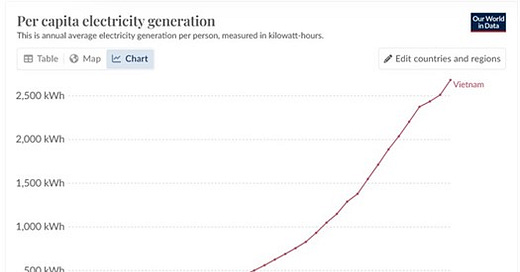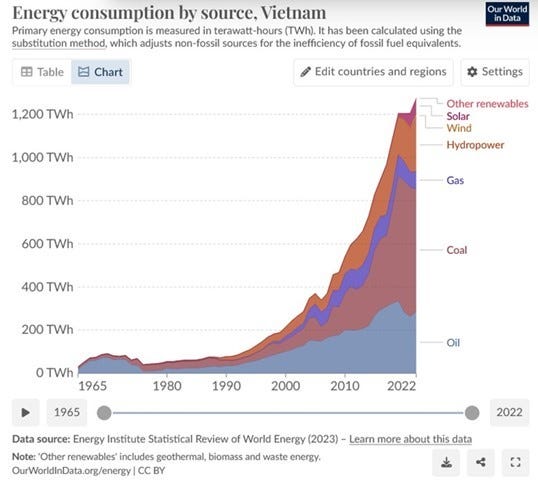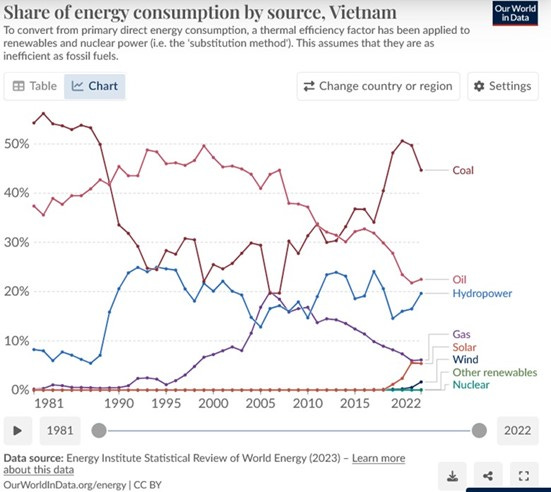Energy Musings - December 13, 2023
We have just returned from a two-week trip to Viet Nam and Cambodia. What we learned about Viet Nam's energy market and a new agreement with Laos point out the challenge with coal.
Viet Nam Demonstrates The World’s Challenge With Coal
Returning to Hanoi after visiting Hą Long Bay, Viet Nam’s UNESCO site of 1,900 islands, our tourist bus passed two of the nation’s coal-fired power plants, including the largest. That is the 1,800-megawatt Vink Tan plant. Quang Ninh province, home to the UNESCO site, is a popular tourist area for the nine million visitors expected to visit Viet Nam this year. (We learned the Vietnamese language does not have any two-syllable words, which is why we use the historical spelling of the country’s name.) But the province is also home to the nation’s primary coal reserves and a mining industry employing over 100,000 workers. Coal accounts for 40% of the province’s fiscal revenues. Coal is important to the Viet Nam economy.
During our trip, our tour guide talked about Viet Nam’s electricity market and pointed out that it derives a substantial portion of its power from hydroelectric plants. That is because there are many dams on the Mekong River and other rivers flowing through the country that generate power. However, China is building additional dams along its portion of these rivers, which will reduce water flow and thus leave Viet Nam’s hydro output flatlining or even declining in the future. That will result in a need for more coal-fired power plants.
On the day before we returned from Viet Nam, a news article highlighted that the government had struck a deal with neighbor Laos for more coal and electricity imports. According to the article in the Saigon News:
“Speaking at the Conference to promote coal trading cooperation between Vietnam and Laos on December 9 in Hanoi, Minister of Industry and Trade Nguyen Hong Dien said that the Ministry of Industry and Trade of Vietnam and the Lao Ministry of Energy and Mines has signed a memorandum of understanding on cooperation in the coal sector. Importing electricity and coal from Laos not only helps economic development between the two countries but also fulfills the dual goals of national security and defense and providing energy for the economy.”
The agreement outlines the responsibilities of designated parties in each country to work out the coal pricing terms, along with plans to reduce Loas coal export taxes. Specific government companies have been assigned the task of investing in infrastructure, storage, and transportation systems to facilitate increased coal trade between the two countries.
During our Viet Nam trip, we learned from our two tour guides about the country’s economy and their everyday life. Tour guides are well-educated after having attended universities. All our tour guides were married with families and have been working in the trade for 20-plus years. Each of them had worked for our tour company for 11-13 years, so they were very professional and knowledgeable.
Viet Nam’s economy ranks 35th in nominal GDP and 26th when measured in purchasing power parity. The economy has been growing rapidly as Viet Nam is benefitting from the shift away from China by export manufacturers. These manufacturers are relocating production out of China to other Asian economies where labor is plentiful and cheap, and power is readily available. This is the result of the geopolitical tension between the United States and China that is growing more intense.
Since 2005, Viet Nam’s economy has grown at a rate between 5%-6% annually with 2022’s growth reaching 8% as the country benefited from the global economic recovery following the Covid pandemic. This year, economic headwinds have slowed the country’s growth rate to just shy of 5%. The World Bank forecasts that Viet Nam’s economy will grow by nearly 7% in 2024 driven by its expanding high-tech manufacturing sector.
Currently, Viet Nam is the seventh largest high-tech exporting nation but is projected to become the fourth largest behind China, Taiwan, and Germany in the next two years. The high-tech goods share of Viet Nam’s exports rose to 42% in 2020 from 13% in 2010. In 2022, the country became the sixth-largest U.S. trading partner by import value, surpassing South Korea. This increase has been powered by the shift in Viet Nam’s exports from textiles and garments to high-tech products.
The following chart of electricity generation per capita in Viet Nam highlights how the country’s economic transformation has resulted in a dramatic increase in power usage. The chart shows that power consumption accelerated beginning in the early 2000s as the focus on globalization and the outsourcing of manufacturing began in earnest in Viet Nam, along with the rest of Asia. We recently learned that competition is growing throughout Southeast Asia as manufacturers abandon China. We were told of a plant that was preparing to leave China landed in Myanmar as its incentives exceeded those offered by Viet Nam. We do not know if that is a one-off situation by a country hungrier for new manufacturers or whether Viet Nam is actively working to slow down its growth.
With globalization and manufacturers seeking cheap labor and plentiful energy, electricity use in Viet Nam has soared since the early 2000s.
When our tour guides discussed their daily lives, they emphasized that they were adding and enjoying modern-day luxuries such as televisions, the internet, and vehicles, but that they still lived much like in the past with daily visits to markets for the ingredients for meals because they did not have the facilities for food storage. Our guides also mentioned that they were careful to shut off all their power-using devices before leaving home to minimize the amount of electricity they used because it was expensive.
Concern about living expenses was not surprising as the GDP per capita in Viet Nam was only $4,320 in 2022. That is just a quarter of the GDP/per capita of China. It is estimated it may take Viet Nam 15 years to match China.
Viet Nam’s area is the size of New Mexico, but the country has a population of 100 million, with 52% under 35 years old. Viet Nam’s population is 50 times the size of New Mexico’s. The country’s population is dynamic and will remain youthful as many people are just reaching the family formation stage which will lead to children that help pull the population’s average age down. However, this pattern requires the continued creation of quality jobs with healthy incomes that will keep pressure on the government to promote economic growth that will require more energy.
The following two charts of energy consumption show the challenges facing the government. These charts also highlight why coal will remain an important source of electricity generation in Viet Nam for many years to come. That will hamper any rush to transition away from fossil fuels, especially coal use. Too many jobs now and in the future will depend on the coal industry.
Fossil fuels, and especially coal, are the primary energy sources powering the Viet Nam economy.
Viet Nam’s energy consumption picture is similar to what other countries are experiencing. The world still relies on fossil fuels to provide roughly 80% of the power needed to operate the economy. In Viet Nam, the growth of hydropower has been dramatic in recent years, but as mentioned earlier this power source’s growth is being limited by China which is damming the rivers that flow into Viet Nam to help meet its power needs. Restricting hydropower’s growth in Viet Nam will force it to rely on its coal and petroleum resources, even with it pushing to grow renewable energy supplies.
Between 2015 and 2022, Viet Nam increased its coal production by almost 20%, bringing it to just under 50 million tons per year. Viet Nam was the world’s 10th largest coal power generator in 2020 with coal providing 52% of the country’s electricity, up from 25% in 2010. Coal use has declined in the past two years, but that is beginning to reverse with the country possessing the youngest fleet of coal-fired power plants less than 10 years old and building new plants. It is unlikely that Viet Nam will be shutting down these modern coal power plants even given the country’s commitment to transition its economy to cleaner power sources.
The chart below shows Viet Nam’s annual share of energy consumption by fuel for the past 41 years. One sees how coal dominated the country’s energy supply in the 1980s, but after falling to a low of 20% in 2005, the share more than doubled to 45% in 2022. Renewables are showing up, with solar being the primary energy source. Much of the solar power we saw and were told about by our tour guides is for heating the hot water tanks located on home rooftops.
Note how coal’s share of power has more than doubled since 2005 as the Viet Nam economy growth accelerated.
The news out of COP28 that the members agreed to language about transitioning away from fossil fuels stands in stark contrast to the energy situation in Viet Nam. Indigenous coal resources are a source of cheap power and employment, critical ingredients for a country that is trying to grow its economy to provide jobs and incomes for its large and growing population. These are the dynamics that seem to be overlooked by elite policymakers who rally every two years for a two-week gabfest and then must go into overtime to come up with an “unsatisfactory” climate change policy agreement. Understanding the plight of people trying to improve their standards of living tells you more about how the global energy transition will move than paying attention to the outcomes of meetings such as COP28.






